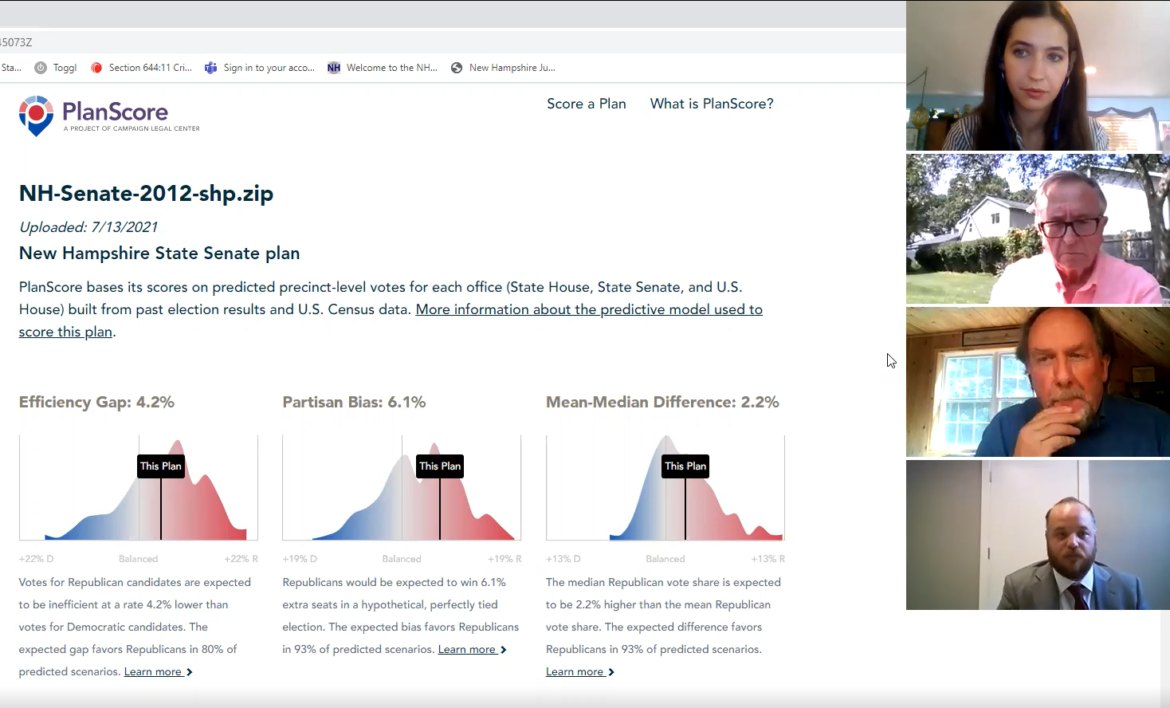By GARRY RAYNO, InDepthNH.org
CONCORD — Several New Hampshire advocacy groups are calling for a fair, open, and transparent process to redraw the state’s political boundaries in light of the release of the 2020 census data Thursday.
Over the next nine months, House and Senate redistricting committees will redraw the political boundaries for House, Senate, Executive Council and the state’s two Congressional seats using the US Census data to adjust boundary lines due to population changes in the state’s cities and towns.
On Thursday, the Fair Maps Coalition held a press conference with representatives of Open Democracy NH, the American Civil Liberties Union of NH, and the League of Women Voters, along with two voters from Pelham and Hudson. They contend the process this year needs to be much more open and transparent than 10 years ago, when many districts — particularly state Senate districts — were gerrymandered to favor Republicans.
Liz Tentarelli, president of the League of Women Voters in the state, said the 2010 process had many problems.
“We have developed a road map for a fair, accessible, and transparent process,” she said. “The public must be kept informed and allowed to participate with meetings held in every county and announced in advance.”
She and others said the public is much more aware of redistricting now than they were 10 years ago.
When asked how the groups intend to ensure the process is more fair and transparent than 10 years ago, Tentarelli said it is up to the members of the special redistricting commission to respect each other and the public enough to do their work in public. Democrats need to have access to the same resources as Republicans, which did not happen in 2011, she said.
“Short of a non-partisan, independent redistricting commission, which we did not get, we have to trust our legislators and trust them to do the right thing,” Tentarelli said.
In 2019-2020, the then Democratically controlled legislature passed an independent redistricting commission both years of the term, but Gov. Chris Sununu vetoed both bills and the legislature was unable to override his vetoes.
Two voters from Hudson and Pelham explained that the way the districts were drawn 10 years ago, disenfranchised Pelham voters.
The two towns were combined into one district as they have been for sometime, but a constitutional amendment passed in 2006 saying any town with a large enough population should have its own representative to the House.
The two towns have a combined population of about 40,000 and have 11 representatives, explained David Hennessey of Pelham, adding that with his community having 14,000 residents, it should have four of its own representatives.
However, with Hudson having a larger population, all but two representatives are from Hudson.
Both towns are heavily Republican, he said, but have very divergent views.
The system is built so you can meet your representative at the grocery store or in town, he said, but that is not what happens with the current district. He suggested the district was drawn to protect some of the then House leadership who live in Hudson.
“We need an open process and to have hearings,” Hennessey said. “I’m not trying to sway it either way, I want a fair shake at picking my four state representatives.”
Henry Klementowitz, ACLU-NH staff attorney, discussed a recent study done of state Senate districts using three metrics to determine if the districts favor one party than the other.
He said under all three metrics, Republicans had an advantage although the number of Democratic and Republican voters are evenly divided.
“Gerrymandering is done by both parties, but this is what it looks like in New Hampshire” Kelmentowitz said. “This is one tool to use this time around to improve (the process) that we can and must implement to ensure fair elections next time.”
The road map released by the coalition would require:
- Two public meetings in each county, one before drawing the maps and one after.
- The committees to create an online portal to allow public access and participation.
- Any data used in redistricting being made available to the public.
And follow a six-item list of criteria in redrawing districts including the federal and state constitutions, as well as community interest, racial an ethnic groupings, and without partisan bias.
The House Special Committee on Redistricting is scheduled to meet Aug. 25 at 10 a.m. in Room 306 of the Legislative Office Building.
The Senate committee has yet to be officially set up or its members named.
Garry Rayno may be reached at garry.rayno@yahoo.com.





